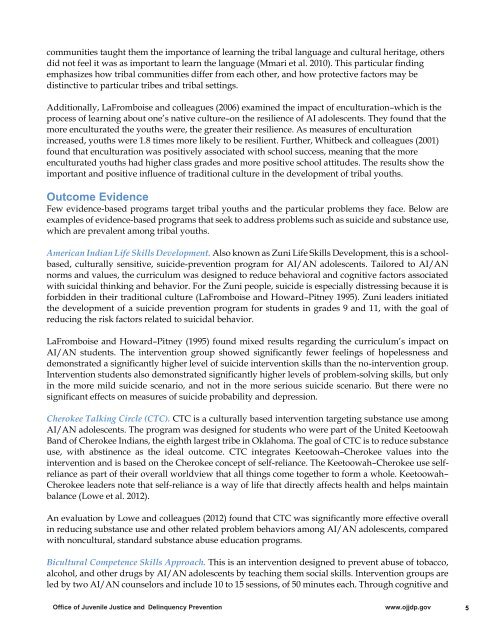Native American Youth In The Juvenile Justice System
Native American Youth In The Juvenile Justice System
Native American Youth In The Juvenile Justice System
You also want an ePaper? Increase the reach of your titles
YUMPU automatically turns print PDFs into web optimized ePapers that Google loves.
communities taught them the importance of learning the tribal language and cultural heritage, others<br />
did not feel it was as important to learn the language (Mmari et al. 2010). This particular finding<br />
emphasizes how tribal communities differ from each other, and how protective factors may be<br />
distinctive to particular tribes and tribal settings.<br />
Additionally, LaFromboise and colleagues (2006) examined the impact of enculturation–which is the<br />
process of learning about one’s native culture–on the resilience of AI adolescents. <strong>The</strong>y found that the<br />
more enculturated the youths were, the greater their resilience. As measures of enculturation<br />
increased, youths were 1.8 times more likely to be resilient. Further, Whitbeck and colleagues (2001)<br />
found that enculturation was positively associated with school success, meaning that the more<br />
enculturated youths had higher class grades and more positive school attitudes. <strong>The</strong> results show the<br />
important and positive influence of traditional culture in the development of tribal youths.<br />
Outcome Evidence<br />
Few evidence-based programs target tribal youths and the particular problems they face. Below are<br />
examples of evidence-based programs that seek to address problems such as suicide and substance use,<br />
which are prevalent among tribal youths.<br />
<strong>American</strong> <strong>In</strong>dian Life Skills Development. Also known as Zuni Life Skills Development, this is a schoolbased,<br />
culturally sensitive, suicide-prevention program for AI/AN adolescents. Tailored to AI/AN<br />
norms and values, the curriculum was designed to reduce behavioral and cognitive factors associated<br />
with suicidal thinking and behavior. For the Zuni people, suicide is especially distressing because it is<br />
forbidden in their traditional culture (LaFromboise and Howard–Pitney 1995). Zuni leaders initiated<br />
the development of a suicide prevention program for students in grades 9 and 11, with the goal of<br />
reducing the risk factors related to suicidal behavior.<br />
LaFromboise and Howard–Pitney (1995) found mixed results regarding the curriculum’s impact on<br />
AI/AN students. <strong>The</strong> intervention group showed significantly fewer feelings of hopelessness and<br />
demonstrated a significantly higher level of suicide intervention skills than the no-intervention group.<br />
<strong>In</strong>tervention students also demonstrated significantly higher levels of problem-solving skills, but only<br />
in the more mild suicide scenario, and not in the more serious suicide scenario. But there were no<br />
significant effects on measures of suicide probability and depression.<br />
Cherokee Talking Circle (CTC). CTC is a culturally based intervention targeting substance use among<br />
AI/AN adolescents. <strong>The</strong> program was designed for students who were part of the United Keetoowah<br />
Band of Cherokee <strong>In</strong>dians, the eighth largest tribe in Oklahoma. <strong>The</strong> goal of CTC is to reduce substance<br />
use, with abstinence as the ideal outcome. CTC integrates Keetoowah–Cherokee values into the<br />
intervention and is based on the Cherokee concept of self-reliance. <strong>The</strong> Keetoowah–Cherokee use selfreliance<br />
as part of their overall worldview that all things come together to form a whole. Keetoowah–<br />
Cherokee leaders note that self-reliance is a way of life that directly affects health and helps maintain<br />
balance (Lowe et al. 2012).<br />
An evaluation by Lowe and colleagues (2012) found that CTC was significantly more effective overall<br />
in reducing substance use and other related problem behaviors among AI/AN adolescents, compared<br />
with noncultural, standard substance abuse education programs.<br />
Bicultural Competence Skills Approach. This is an intervention designed to prevent abuse of tobacco,<br />
alcohol, and other drugs by AI/AN adolescents by teaching them social skills. <strong>In</strong>tervention groups are<br />
led by two AI/AN counselors and include 10 to 15 sessions, of 50 minutes each. Through cognitive and<br />
Office of <strong>Juvenile</strong> <strong>Justice</strong> and Delinquency Prevention www.ojjdp.gov 5

















